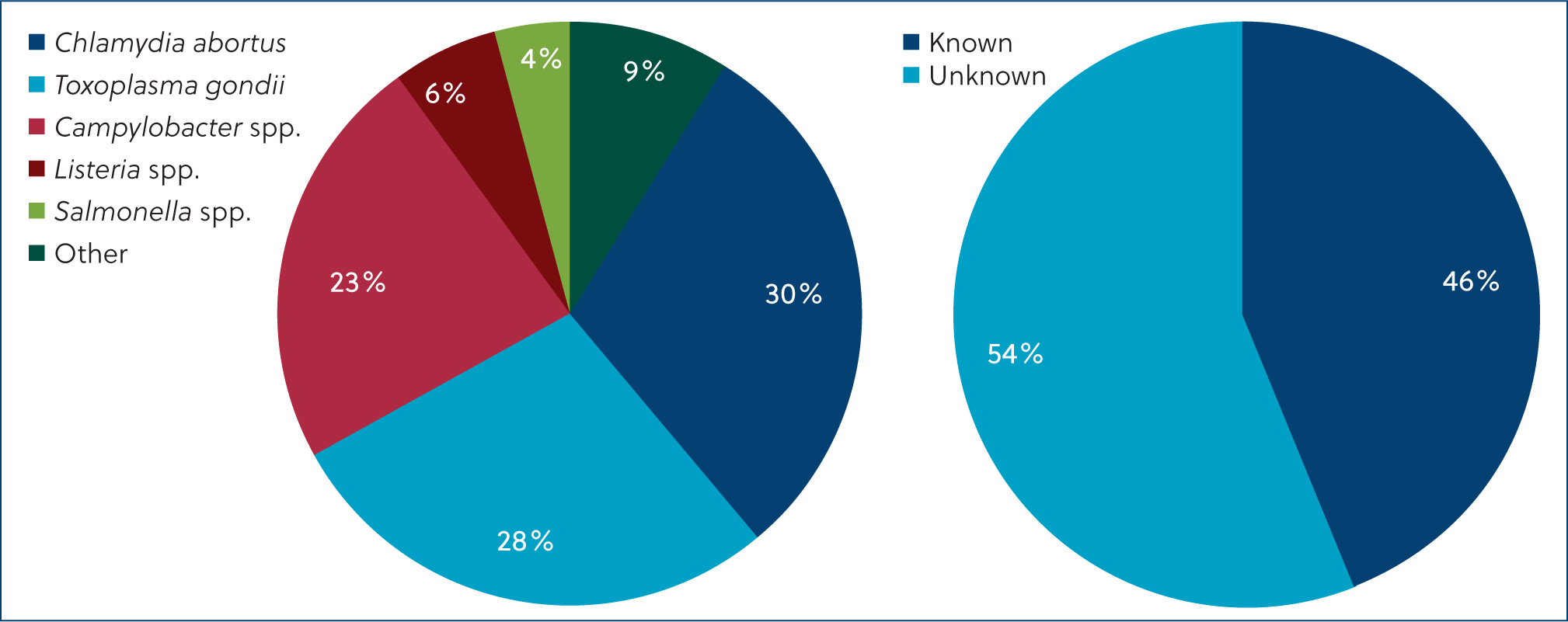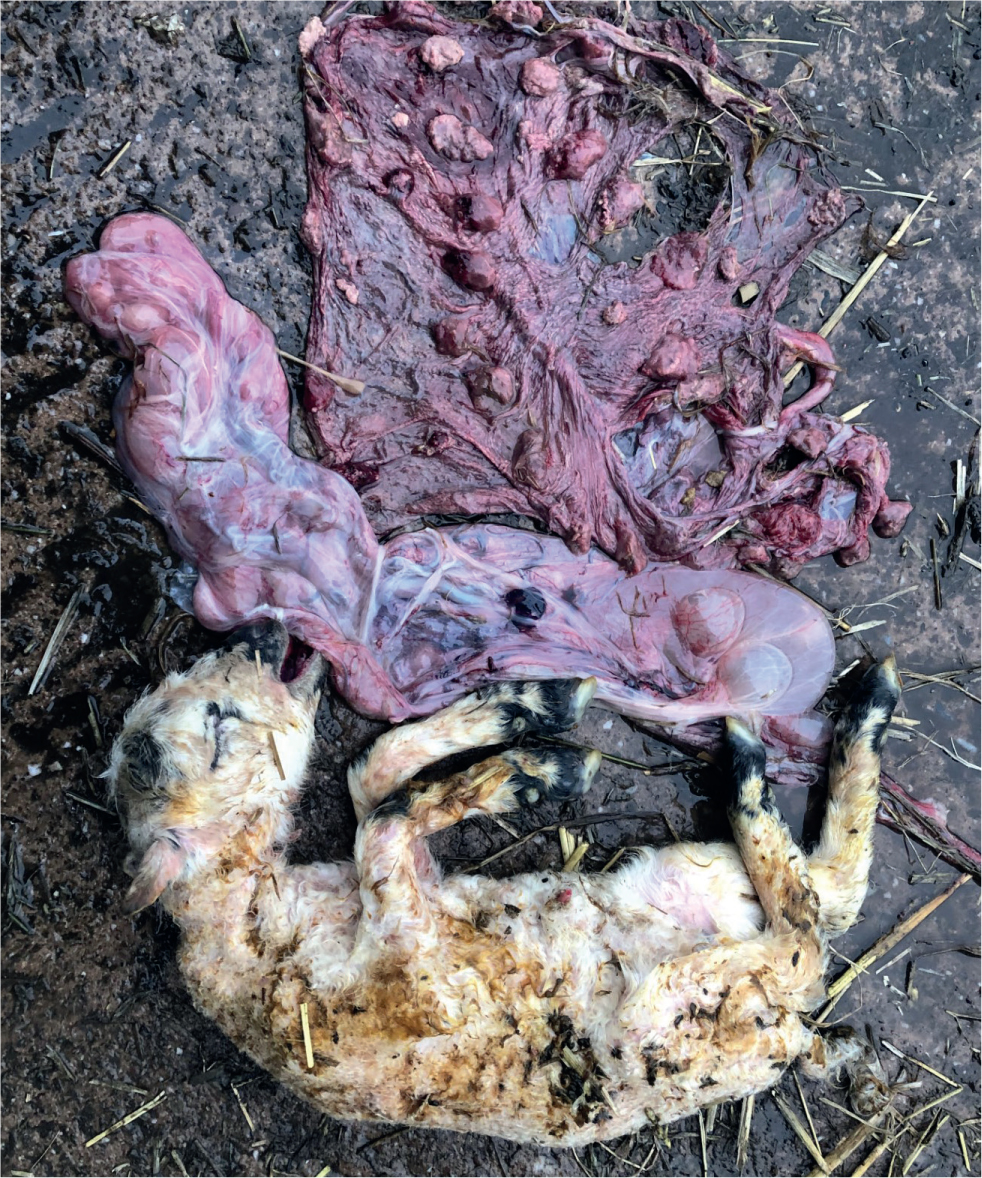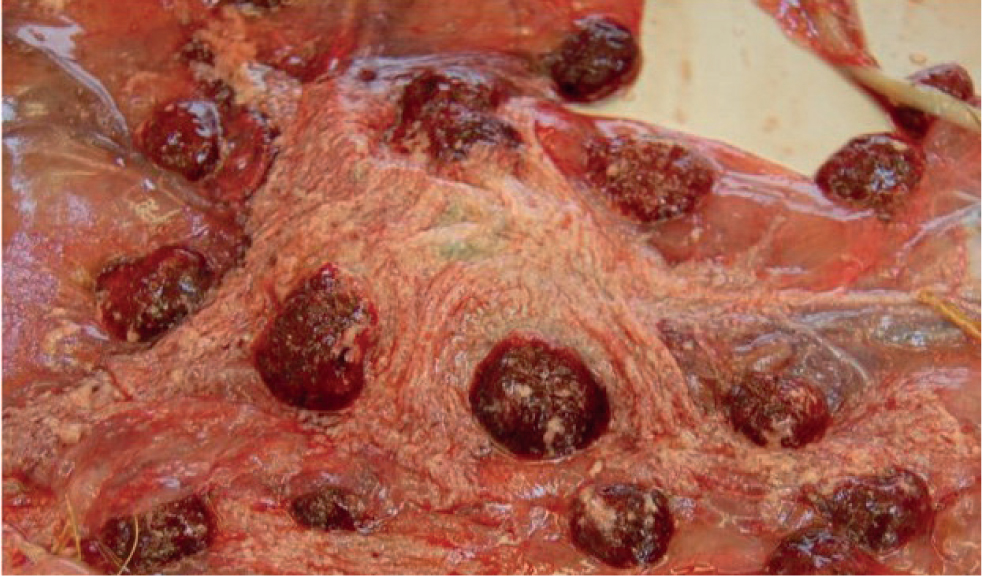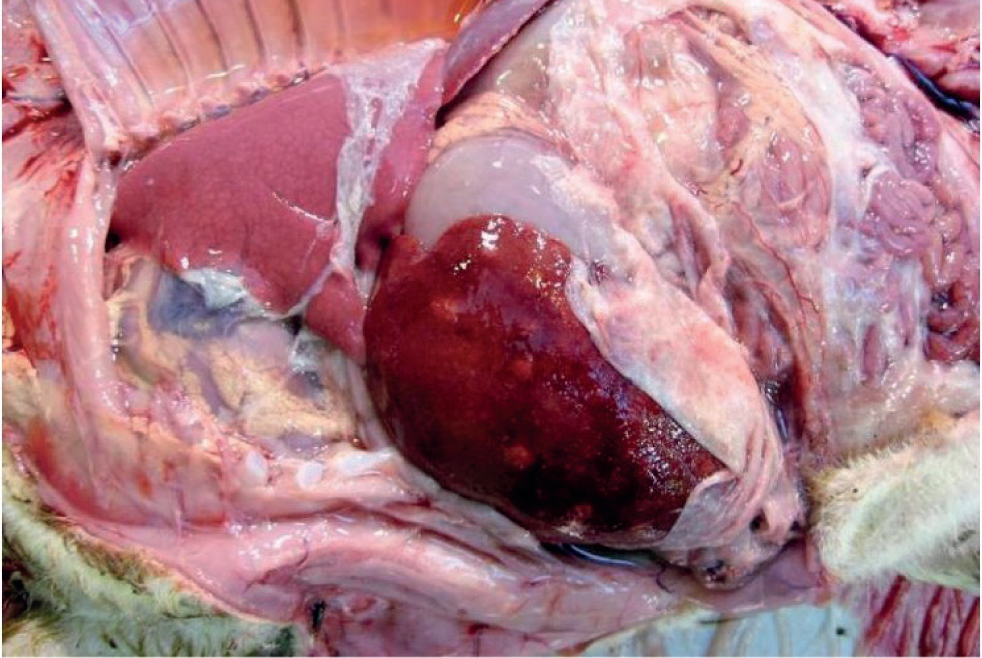In 2021, Ceva Animal Health estimated the cost of a lamb abortion to be £85 – for an outbreak of Chlamydia abortus, this is roughly £2550 lost per 100 ewes (Mearns, 2007). C. abortus, Toxoplasma gondii, Campylobacter spp., Listeria monocytogenes and Salmonella spp. are the most common causes of infectious ovine abortion (Figure 1), with other notable pathogens including Schmallenberg virus and Border disease. Occasionally, abortion storms will occur due to these infections, causing more than 20% of ewes in a flock to abort or give birth to weak lambs (Sheep Health and Welfare Group, 2020). Several of these pathogens have been proven zoonotic, causing miscarriage in pregnant women. This, in addition to the previously mentioned economic consequences, highlights an important need to investigate preventative therapies.

Despite introduction of the associated C. abortus vaccines, it is not uncommon to treat sheep with tetracyclines during an abortion storm (Sheep Health and Welfare Group, 2020) and, similarly, antibiotic treatments are still used in flocks with T. gondii – although where the causative agent is known to be T. gondii, antibiotics are completely contraindicated as T. gondii is a parasitic protozoan. However, due to the growing concern around antimicrobial resistance and research demonstrating the benefits of vaccines, it is now increasingly common to inoculate ewes prior to mating, to the extent that the National Office of Animal Health (NOAH) lists vaccination against T. gondii and C. abortus as category one – ‘highest priority’ vaccination – in the UK flock (Statham et al, 2022). This article will review the vaccination protocols for the most common pathogens, their efficacy and the uptake of these vaccines.
UK benchmark
Benchmarking is a useful tool for allowing farmers to assess statistics of predefined key performance indicators (KPIs). This can provide a way to monitor progress or identify problems, by comparing numbers against previous years or industry targets. A common KPI to measure is abortion percentage, defined by the equation shown in Figure 2 (Farm Advisory Service, 2020). The abortion percentage target is <2%, and farmers with an abortion percentage above this should consult their vet for investigation. Investigations include post-mortem examination of the foetus and placenta and blood sampling in the ewe. Details of post-mortem examination can be found on the Agriculture and Horticulture Development Board website (2023a). Additionally, farmers may make use of MSD's scheme FlockCheck. FlockCheck is a subsidised diagnostic service allowing identification of pathogens T. gondii, C. abortus or both (Hunter, 2023). Similarly, CEVA test for C. abortus with the AssureEwe scheme, which is also subsidised (Ceva Animal Health, 2021).

Investigation and sampling
There are a range of methods for the investigation of potential pathogens – a summary is presented in Table 1. However, it must be noted that it may be more economically viable to submit the whole aborted foetus and placenta (Figure 3) to APHA for an all-inclusive post-mortem examination, rather than to a private vets where post-mortem examination, sample collecting and additional testing could result in a higher cost to the client.
Table 1. Samples required for diagnosis of ovine abortion, with associated tests.
| Pathogen | Sample required | Diagnostic tests |
|---|---|---|
| Chlamydia abortus | Placenta with a cotyledon and surrounding membrane as clean as possible.If not possible, can do impression smear of tongue | PCRAntigen testHistopathologyObservation of placenta |
| Toxoplasma gondii | Placenta with a cotyledon and surrounding membrane as clean as possible.Foetal fluid Foetal brain (fresh) | Histopathology Serology |
| Campylobacter fetus or Campylobacter jejuni | PlacentaFoetal stomach contentsLung and/or liver | Aborted foetal tissues and placentas:PCR (primers developed for both).Fluorescence in situ hybridization can be used to identify and differentiate Campylobacter spp. in fixed placenta |
| Salmonella abortus ovis or Salmonella spp | Foetal stomach contentsVaginal swab of ewe | Culture and PCRSerology |
| Listeria monocytogenes | PlacentaFoetus | Immunoflourescence assay |

Chlamydia abortus and associated vaccines
Chlamydia abortus epidemiology
C. abortus, also known as enzootic abortion of ewes (EAE), is endemic in sheep and is the most common cause of ovine abortion in the UK, accounting for 30% of known causes of abortion in 2022 (Animal and Plant Health Agency, 2022) (Figure 1). It occurs worldwide, with the exception of Australia and New Zealand (NSW Government, 2023), and is usually introduced when an infected animal joins the flock. C. abortus is a Gram-negative bacterium, and typically has two presentations. The first presentation is a novel outbreak due to introduction of C. abortus into the flock, while the second is an enzootic disease to ewe lambs (Foster, 2017). It is transmitted from infected placentae to the oral cavity of another ewe. C. abortus causes abortion in late gestation, and ewes will only abort once after infection – the timing of infection determines whether the ewe will abort their current pregnancy, or subsequent pregnancy. The pathogen causes placentitis, presenting as oedema and thickening of the intercotyledonary area as highlighted in Figure 4 (MSD Animal Health, 2023a).

C. abortus is still considered the leading cause of ovine abortion, despite several highly efficacious vaccines being licensed in the UK. It has been reported that C. abortus costs the UK sheep industry an estimated £20 million/annum. Despite this high economic impact of C. abortus (Milne et al, 2009), it is estimated at present that only 36% of sheep flocks are vaccinated (Sheep Health and Welfare Group, 2020). Moreover, the NOAH (Statham et al, 2022) vaccine report claims a 41% C. abortus and 25% T. gondii vaccine uptake in first-time breeding ewes.
Enzovax
One of the options available, with demonstrated high efficacy, is the live attenuated vaccine Enzovax (MSD Animal Health, 2023b). In multi-strain challenge studies undertaken with unvaccinated controls, the number of abortions in animals treated with Enzovax were less than 10% of the control group. Furthermore, Enzovax has been demonstrated to reduce bacterial shedding by up to 90%, and provides immunity up to 4 years from vaccination. In Table 2 it is advised not to use this vaccine alongside oxytetracycline; field studies have shown that the reduction in bacterial shedding is less than 50% in ewes which have been treated with this antimicrobial. Live vaccines cannot be used in already pregnant sheep.
Table 2. Vaccination protocols for vaccines against ovine abortion
| Pathogen | Vaccine | Dose | Basic vaccination | Revaccination | Contradications |
|---|---|---|---|---|---|
| Toxoplasma gondii | Toxovax | 2ml IM | One dose at least 3 weeks prior to matingEwe lambs: from 5 months of age Shearlings and older ewes: within 4 months prior to mating | After 2 yearsOne dose at least 3 weeks prior to mating | Do not use during pregnancy |
| Chlamydophila abortus | Enzovax | 2ml SC or IM | One dose at least 4 weeks prior to matingEwe lambs: from 5 months of ageShearlings and older ewes: within 4 months prior to mating | Recommended every 3-4 years depending on farm management practices and conditions | Do not use during pregnancyDo not vaccinate less than 4 weeks prior to matingDo not vaccinate animals undergoing treatment with antimicrobials, in particular tetracyclines |
| Chlamydophila abortus | Cevac chlamydia | 2ml SC or IM | One doseEwe lambs: from 5 months of ageShearlings and older ewes: within 4 months prior to mating | N/A | Do not use during pregnancyDo not vaccinate less than 4 weeks prior to matingDo not vaccinate animals undergoing treatment with antimicrobials, in particular tetracyclines |
| Chlamydophila abortus Salmonella enterica subsp. enterica serovar Abortusovis | Inmeva | 2ml SC | 2 vaccines with an interval of 3 weeksEwe lambs from 5 months of ageFirst dose: at least 5 weeks prior to matingSecond dose: 3 weeks after the first dose | A single booster dose prior to each matingNo later than 1 year after basic vaccination | Vaccinate healthy animals onlySafe to use during pregnancy and lactationNot recommended in the last month of gestation |
| Campylobacter fetus subsp. Fetus Campylobacter jejuni | Campyvax4 | 1ml SC | Two doses, with an interval of 4–8 weeksEwe lambs: CheckShearlings/older ewes: Check | A single booster dose prior to each mating, annually | Not mentioned.Unlicensed but can be imported on a special import certificate (SIC) |
Cevac Chlamydia
Another live attenuated vaccine is Cevac Chlamydia (Ceva Animal Health Ltd). Again, live vaccine cannot be used in already pregnant sheep. Similarly to Enzovax, particular attention should be drawn to using Cevac Chlamydia alongside antimicrobials, specifically oxytetracycline. Ceva suggests considering re-vaccinating animals that have previously been vaccinated 4 or more years before, so a schedule similar to Enzovax (Ceva Animal Health, 2020).
Inmeva
Inmeva (HIPRA) is an inactivated vaccine, which also provides immunity to Salmonella enterica subsp. enterica serovar Abortusovis. This vaccine can be used during pregnancy. Vaccination reduces shedding of both organisms; however, unlike the previous C. abortus vaccines discussed, Inmeva revaccination must be administered no later than 1 year following the initial vaccination. Results from a 2020 study indicated a 75% reduction in the clinical signs and 55% reduction in shedding of C. abortus specifically (Montbrau et al, 2020). A further study confirms the efficacy of the vaccine against S. abortusovis, with significant decreases in abortion and bacterial vaginal excretion in the vaccinated ewes (García-Seco et al, 2021); however, S. abortusovis is currently not seen in the UK (Crilly et al, 2021).
Toxoplasma gondii
T. gondii epidemiology and pathology
Discovered in 1908, T. gondii is a globally widespread protozoal parasite (Dubey, 2008). With an indirect lifecycle, the definitive host is the cat, and the intermediate hosts can fall within a range of many mammals – including sheep. It is one of the leading causes of ovine abortion in the UK – being attributable to 28% of known causes in 2022 alone (Animal and Plant Health Agency, 2022) as seen in Figure 1. Moreover, high levels are demonstrated with data from FlockCheck, with T. gondii found to be present in one or more ewes in 66.4% of the 375 UK sheep farms tested (VetRecord, 2021). T. gondii presents with focal necrosis in the cotyledons of the placenta, causing a whitened appearance, but the only way to obtain a definitive diagnosis is through histopathology of the aborted foetal organs. Additionally, antibody testing on foetal heart blood can aid diagnosis (MSD Animal Health, 2023c). Figure 5 demonstrates the classic whitened appearance.

Toxovax
The only vaccine licensed in the UK against T. gondii, Toxovax is a parasitic vaccine designed to stimulate active immunity in the sheep. Containing >105 living tachyzoites, the vaccine is injected intramuscularly at least 3 weeks before mating or being artificially inseminated. This generates a temporary infection in the ewe for around 2 weeks, before being eradicated by the immune system (Innes and Wastling, 1995). This allows the immune system to be primed in the event of T. gondii oocysts being ingested. As seen in Table 1, time of first injection is dependent on whether the ewe is a lamb or older (NOAH Compendium, 2023). Toxovax has been shown to be efficacious when administered on the same day, but not mixed, with Enzovax.
Campylobacter
Campylobacter spp. epidemiology and pathology
Campylobacter spp. can be separated into various species, including the more common Campylobacter fetus subsp. fetus and Campylobacter jejuni. Infection with both C. fetus or C. jejuni both typically result in late-term abortion. The predominant source of infection is buying in carrier sheep, and placing them in an immunologically naïve flock (National Animal Disease Information Service, 2023). Campylobacter spp. causes placentitis and gross hepatic lesions (Figure 6), although gross foetal lesions are seemingly uncommon. Microscopic lesions were most commonly identified as placentitis, placental vasculitis and foetal pneumonia (Yaeger et al, 2021).

Both C. fetus and C. jejuni predominantly inhabit the intestines, and are transmitted faecal–orally from infected placentae of one ewe to an immunologically naïve ewe, or through oral secretions (Foster, 2017). C. jejuni recently took over as the predominant species in the US, and has additionally been demonstrated as tetracycline-resistant (Sahin et al, 2008). As tetracyclines were previously the treatment of choice, this indicates a clear reason to pursue other alternatives.
Campyvax4
Campyvax4 is the only unlicensed vaccine discussed in this review. If required, it can be imported on a special import certificate (SIC) from Australia, where it is manufactured, by a veterinary surgeon for use in the UK. It is an inactivated vaccine which primarily protects against C. fetus, but induces an additional immune response to C. jejuni, providing some protection against this species (MSD Animal Health, 2023d). The vaccine is initially administered in two doses, 4–8 weeks apart, and then once in each subsequent year.
Campylobacter jejuni vaccine research
As discussed, Campyvax4 elicits an immune response to C. jejuni, but has not been reported as being fully protective from ovine abortion against this strain (MSD Animal Health, 2023d). Research in the US has indicated that an experimental homologous bacterin induced significant protection against C. jejuni, demonstrating an 80% protection rate. This was notably increased from the control group, and the two commercial vaccine groups (containing C. fetus and C. jejuni strains) used as comparison (Wu et al, 2020). As a tetracycline-resistant C. jejuni strain is the predominant threat in the US (Sahin et al, 2008), this calls for further research into vaccine development.
Common causes of abortion which lack vaccines
Listeria spp.
L. monocytogenes and L. ivanovii cause ovine abortion in late gestation. Listeria spp. commonly emerge in spoiled silage, and occasionally soil in poor conditions (OIE Terrestrial Manual, 2018). Less commonly, it may be horizontally transferred from an infected ewe. Infection with L. monocytogenes was recently found in conjunction with T. gondii, opening up the conversation around multifactorial abortion (De Angelis et al, 2022), and whether investigating this further would allow for novel approaches to treatment.
Non-infectious abortion
If infectious pathogens of abortion can be eliminated, there are a variety of non-infectious causes to consider. It has been suggested up to 47.8% of ovine abortion is non-infectious (Vidic et al, 2007). Nutritional deficiencies, hormonal imbalances, trauma, stress, mycotoxins and genetic abnormalities can all be attributed to abortion (Yadav et al, 2021). It is challenging to accurately diagnose these as there can be a significant delay between exposure to the cause, and the abortion itself. There is also far less research in this area, considering the high prevalence suggested by Vidic et al (2007).
Dog attacks
Sheep worrying attacks by dogs are appearing to rise, with 70% of surveyed farmers experiencing an attack in the last 12 months (National Sheep Association, 2023). In the same survey, almost 70% of respondents reported production losses from these attacks, including abortion. It has been estimated that the cost of UK dog attacks has risen 50% since the pandemic took place (National Farmers' Union, 2023), another indication that they are increasing. The impact is not only on the welfare of the farmer and the sheep, but also the dog – in some situations it is legal for the farmer to shoot the dog as a last resort (UK Government, 2023).
NOAH vaccine guidance
In their publication (Statham et al, 2022), livestock vaccines are categorised by sector (dairy, beef or sheep) and into NOAH category one or NOAH category two. Category one vaccinations are viewed as the highest priority vaccinations, with a critically important role for flock health. Ultimately, the stance taken by NOAH is that category one vaccines should be administered by default unless a specific discussion between the vet and their client is had (and regularly reviewed) as to why justification for not administering can be given. T. gondii and C. abortus vaccination both fall into category one, and with funded veterinary visits for health planning under DEFRA's Animal Health and Welfare Pathway this year, there is a clear opportunity for vets to be more proactive in discussing vaccination use with clients (UK Government, 2022).
Vaccine uptake
Vaccination usage by the UK sheep industry fluctuates annually with influencing factors including supply issues and the market price (UK Government, 2022). One of the initial RUMA targets for the sheep industry was to increase the use of C. abortus vaccination by 5% annually from 2017 to 2020 (to reduce ovine abortion and peri-parturient tetracycline usage) (RUMA, 2020). While good progress has been made, this target was not reached as the number of doses increased only 14.4% from 2014 to 2021 (Agriculture and Horticulture Development Board, 2023b).
Perhaps unsurprisingly, C. abortus vaccination is more commonly used than T. gondii, with 50% and 31% of the UK breeding flock believed to be vaccinated respectively (Agriculture and Horticulture Development Board, 2023b). This remains someway behind clostridial diseases (63%) as the most commonly used vaccine type in the UK flock.
With initiatives such as the RUMA targets and NOAH categorisation of vaccination for livestock prompting vets and farmers to discuss abortion vaccination, the other area that needs attention is the extent to which farmers comply with vaccination protocols and techniques. In their study of 370 farmers, Hall et al (2022) reported that 45.5% of respondents kept vaccines for more than 48 hours after broaching, with under 10% identifying the correct site for intramuscular injection and 26.1% identifying the correct subcutaneous sites (Hall et al, 2022). More reassuringly, over 80% showed an appetite for vaccination training courses and an increase in identification of the correct sites was observed following training courses.
A previous ‘round table’ discussed the benefits and approaches to running successful medicines training courses for ruminant farmers (Button et al, 2023) and the authors believe that these could definitely be extended to include a practical segment of vaccination training. With the increase in ‘vettech’ services offered by practices across the UK and Ireland, the profession may also see appetite for vettech vaccination services being delivered to sheep clients in the way practices promote a cattle vaccination service (LLM Farm Vets, 2018; Farm Vet Solutions, 2023; ProStock Vets, 2023).
Anecdotally, one of the authors finds that their clients commonly advise that T. gondii vaccine is expensive (one online retailer sells at £6.11/dose or £3.06/ewe/year as datasheet immunity is two years (Farmacy, 2023), compared to other commonly used sheep vaccines. However, using the 2021 June price of 692.9p/kg (Agriculture and Horticulture Development Board, 2023c) and an average lamb deadweight of 19.7kg (Statista, 2021) the client needed to only rear two additional lambs to point of sale the following year to cover the £305.50 (Farmacy, 2023) for 50 doses.
For C. abortus, Ceva (Mearns, 2007; Farmacy Online, 2023) report an average cost of £85/abortion against a cost of £300 per 100 ewes vaccinated (or £3/ewe) and therefore demonstrate in much of their literature that if you can avoid four abortions over the 3-year lifespan of vaccination-derived immunity, clients can recoup the cost of vaccination with Cevac.
Conclusion
To conclude, ovine abortion is costly to the farming industry, and – for the most part – highly preventable for both infectious and non-infectious causes. Prevention relies on compliance from farmers, education of stakeholders and further research into the area. It is also important to note it is believed there is an issue with underreporting abortion in sheep, and equally important to consider the effect this has on the above figures.
KEY POINTS
- Ovine abortion is a worldwide problem for sheep farmers, and can be caused by a variety of infectious and non-infectious causes.
- Chlamydia abortus, Toxoplasma gondii, Campylobacter spp., Listeria monocytogenes and Salmonella spp. are the most common causes of infectious ovine abortion.
- There are several efficacious vaccines available in the UK targeting abortion-associated pathogens, to be administered before mating.
- Vaccine uptake is variable, and more emphasis on farmers complying with protocols needed.

